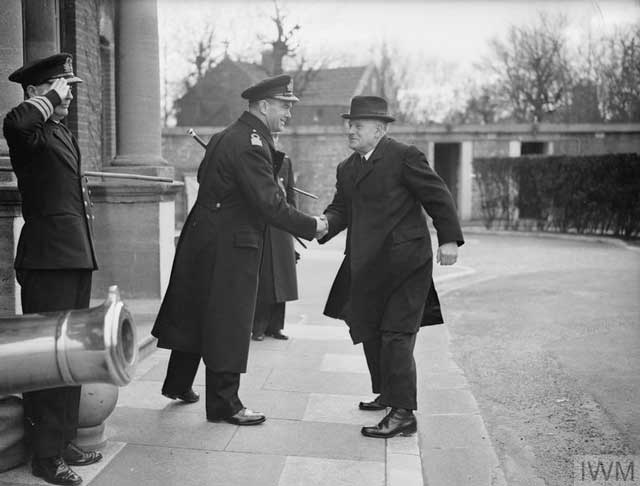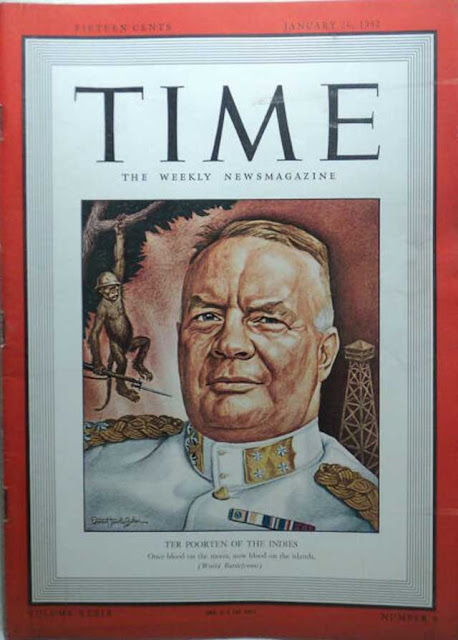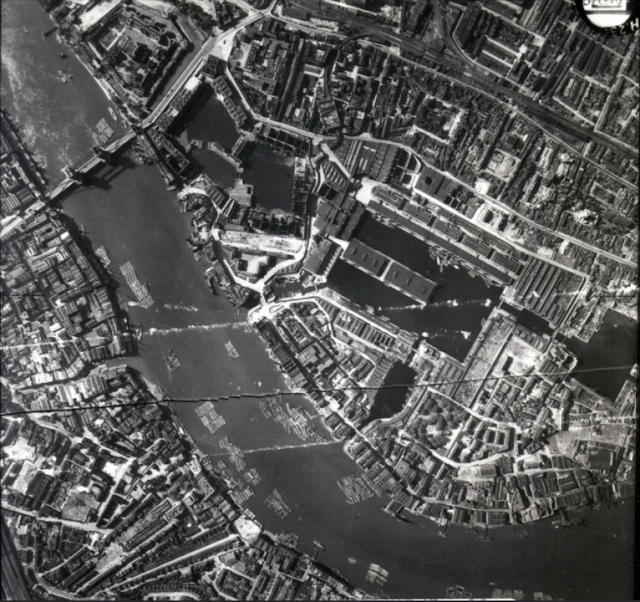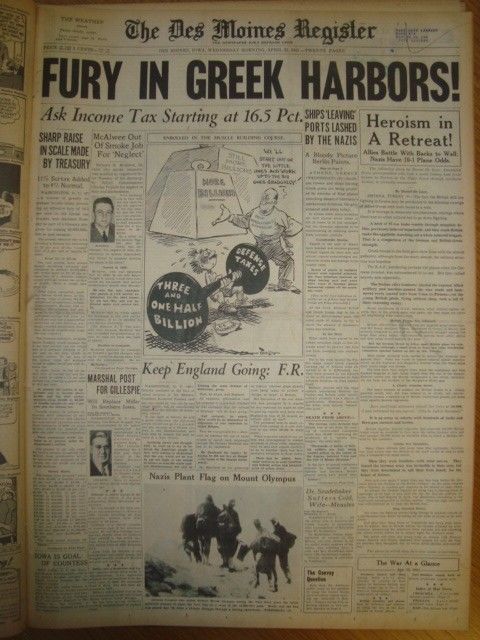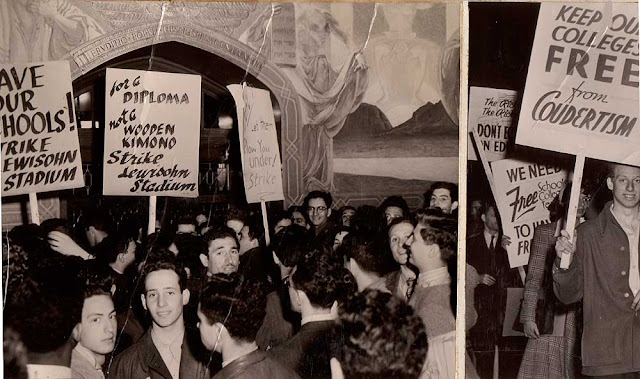Thursday 5 June 1941
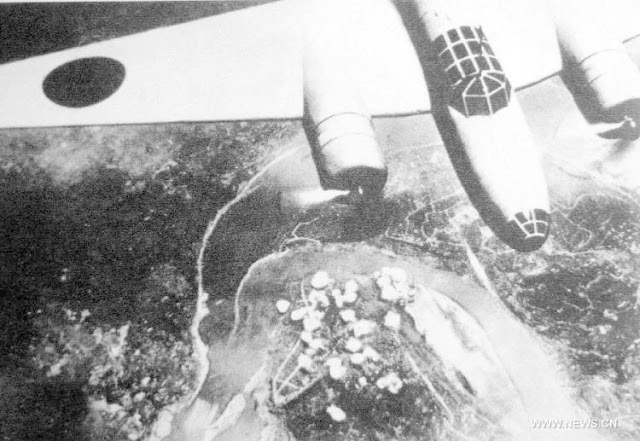 |
| The Japanese bombing Chungking. |
Syrian/Lebanon Campaign: The RAF sends three Blenheims to raid Aleppo airfield in Syria on
5 June 1941. The Luftwaffe and Italian Regia Aeronautica have used Aleppo as a transit hub for flights to Iraq, and the Italians still have CR.42 fighters and SM.79 transports there. Defending French Morane 406 fighters fail to avert the attack, which destroys a hanger and plane on the ground.
The Vichy French bomb the Transjordanian capital of Amman.
The British Middle East Command is ironing out the details of its planned invasion of Syria, Operation Exporter. General Maitland Wilson, who is planning the operation, will command the initial stages of the operation from the King David Hotel in Jerusalem. Then, he will hand off the direction of operations to Major-General John Lavarack of the 1st Australian Corps once Damascus and Beirut have fallen and the campaign effectively has been decided.
Brigadier Sydney Rowell, chief of operations of the Corps, argues that control of operations should vest in the local commanders from the start, but Thomas General Blamey, on Middle East Commander General Archibald Wavell's staff in Cairo, overrules him. The British feel, from intelligence information gathered from French defectors, that the invasion of Syria will be a simple affair, and Blamey wants to "not rock the boat." Rowell and Blamey have a lack of respect for each other which rapidly is turning personal.
Rowell and headquarters for the 1st Australian Corps move to Nazareth in anticipation of the invasion.
The Royal Navy continues re-deploying its ships to support the invasion of Syria. Anti-aircraft cruiser HMS Coventry and destroyers Hero and ISIS leave Alexandria. They are to rendezvous with troopship Glengyle at Port Said, which is to embark on invasion troops.
In Iraq, the British occupy Kirkuk.
 |
| Reichsführer-SS Heinrich Himmler arrives at Lodz Ghetto (Litzmannstadt) on 5 June 1941. He is in a BMW 355 bearing his standard "SS-1" plates. Visible (grey hair) is Mordechai Chaim Rumkowski, the “leader” of the Jewish community. Himmler is on an inspection tour of the manufacturing process at the camp (they make uniforms and other items). Karl Wolff, Himmler's Chief Adjutant, is visible, as is Ghetto Administrator Hans Biebow (face at extreme left, over the shoulder of the political officer). Poland at this time is a beehive of activity due to the looming start of Operation Barbarossa. |
European Air Operations: Before dawn, the Luftwaffe bombs Birmingham, England. However, bombing accuracy is extremely poor, and the bombs generally fall in the countryside.
Luftwaffe ace Heinz Wiest (six victories) of JG 51 perishes in a flying accident.
East African Campaign: East African 22nd Infantry Brigade captures over 1000 Italian troops near the Omo River at Sciola in Galla-Sidamo.
 |
| Heavy cruiser ORP Burza H-73 seen off Bangor, Ireland, 5 June 1941. |
Battle of the Atlantic: The Royal Navy gets another victory in its campaign to eradicate the German supply fleet from the North and South Atlantic. Cruiser HMS London, accompanied by destroyer Brilliant, find 9789-ton German tanker Egerland midway between the Cape Verde Islands and Brazil. Following standard procedure, the 94-man German crew scuttles the Egerland and go into captivity. The Royal Navy now has eliminated over half the German supply network in only a few days, and this inevitably will hinder extended U-boat operations.
U-48 (Kptlt. Herbert Schultze), on its 12th patrol out of Kiel in the Atlantic midway between Ireland and St. John's, torpedoes and sinks 6054-ton British tanker Wellfield. There are 8 deaths and 34 survivors. The survivors are picked up by Norwegian freighter Heina.
The Luftwaffe bombs and sinks 3540-ton British coal hulk Himalaya at Portland, Dorset.
The Luftwaffe bombs and sinks 73-ton Royal Navy balloon barrage drifter Lavinia L. off Sheerness. There is one death.
Royal Navy 505-ton trawler Ash hits a mine and sinks in the Thames Estuary. There are some men wounded, but everybody survives.
British 6278-ton freighter Myrmidon hits a mine in the Crosby Channel. The Myrmidon makes it back to Liverpool. Eventually, it heads to New York for complete repairs.
Royal Navy destroyer Matabele hits a submerged object off Barrow. It has to return to Barrow for repairs and is out of service until August. With so many vessels being sunk all around Great Britain, underwater hazards not marked on charts are multiplying and becoming a serious problem.
The Royal Navy continues landing ground reinforcements in Iceland. This month, an infantry battalion and artillery battalion arrive. The British occupation presence is rapidly building to a total of 25,000 men. The Icelandic government remains officially neutral but offers no resistance to the British. The British build numerous facilities at Reykjavik and elsewhere, including No. 30 General Hospital and No. 50 General Hospital. The British are preparing to hand off occupation duties to the United States, but that process has not yet begun.
Canadian corvettes HMCS Buctouche (Lt. William W. Hackney) and Sherbrooke (Lt. Commander Eric G. M. Donald) are commissioned.
U-573 (Kptlt. Heinrich Heinsohn) is commissioned in Kiel.
The Kriegsmarine places an ambitious order for 102 new U-boats to be built. Germany only has so much steel, most imported from Scandinavia, and the army and navy both need what is available for their projects. Thus, there is constant competition for steel allotments, which is a symptom of a larger issue facing the Reich.
 |
| Fiat CR-42-Falco 161 Gruppo CT Stormo Autonom 164a 164 5 MM7475, Rhodes, June 1941. |
Battle of the Mediterranean: The Wehrmacht announces that its final count of prisoners taken on Crete amounts to about 15,000 British and Commonwealth troops. This number generally is considered a little high, the number is probably closer to 12,000, but there is no question that a lot of Allied troops become POWs on Crete. Many British and Commonwealth troops still remain at large, hiding in caves and with local villagers.
Royal Navy submarine HMS Triumph encounters three small Italian ships in the Gulf of Sirte along the coast southeast of Misrata. Using its deck gun, Triumph sinks escorting Italian gunboat Valoroso, 245-ton freighter Frieda and 244-ton freighter Trio Frassinetti.
Royal Navy submarine HMS Unique (Lt. A.F. Collett, RN), on its 9th war patrol, makes a daring intrusion into Lampedusa Harbor early in the morning. At 08:22, it torpedoes and sinks 736-ton Italian freighter Arsia inside Lampedusa Harbor. Collett has to fire two torpedoes because the first at 07:53 misses and hits the shore just astern of the ship. There are no casualties. Shrapnel from the Arsia damages 275-ton freighter Egusa and small fishing boat Giuseppe Padre (two casualties). Some sources place this as occurring on 3 June, and that Unique arrives back at Malta today.
Operation Rocket is in progress. This is another in a regular series of operations from Gibraltar to fly fighter aircraft to Malta. Aircraft carriers HMS Ark Royal and Furious carry Hawker Hurricanes, escorted by battlecruiser Renown and six destroyers. The two carriers, leading two separate groups, intend to fly off 43 Hurricanes once they are within range of Malta.
At Alexandria, Royal Navy submarine HMS Rorqual departs with a load of supplies for Malta. These trips take almost a week now because of the Luftwaffe's control over the skies now that Crete is in German hands. Australian destroyers HMAS Vendetta and Voyager also depart, carrying supplies to Tobruk. Vendetta and Voyager complete the journey after dark, quickly unloading and returning to Mersa Matruh before dawn.
The British reinforce Cyprus with Australian troops. The Germans, however, have their eyes fixed on the East and no longer are interested in more island adventures in the Mediterranean.
At Malta, the military government sends the War Office a warning that the island is not prepared to withstand a Luftwaffe invasion using airborne troops, as on Crete. The cable notes that local air superiority has been lost. On the bright side, the cable bravely states that "Malta is in a much better position to stand up to it than was Crete." The problem is that the risk of airborne landings requires defenses inland, while the danger of seaborne landings requires troops guarding the beaches. The British forces on Malta have insufficient troops to guard against both possibilities simultaneously. The cable concludes with a request for three squadrons of fighters (meaning an additional squadron to add to the two already present), two infantry battalions and additional artillery.
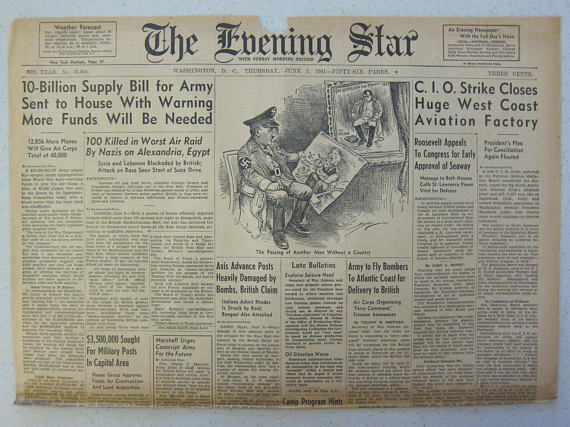 |
| The Evening Star, Washington, D.C., 5 June 1941. |
Battle of the Indian Ocean: Convoy VK-2 departs Sydney bound for Wellington. The two ships are escorted by Australian heavy cruiser HMAS Australia and New Zealand light cruiser HMNZS Achilles.
Dutch/French Relations: The government of the Dutch East Indies closes the Karimata Strait and Sunda Strait to Vichy French vessels. The French in Indochina is completely dominated by Japanese Imperial forces.
 |
| Chinese packed tight into a Chungking air-raid shelter. Could the air could in such an enclosed space possibly be enough for all those people? Well... the Chinese sadly found out it wasn't enough. |
US/French Relations: The US State Department issues a statement expressing its "sympathetic friendship and thought for the well-being of the French people and the French Empire." It notes that the US plans "to maintain full and friendly diplomatic relations with the French Government at Vichy."
US Government: President Roosevelt's administration requests funding of $10.4 billion in army defense spending in the fiscal year 1942 (which begins in September 1941). This is a vast sum for the time, especially with the country still supposedly at peace.
 |
| Chinese packed tight into a Chungking air-raid shelter. |
China: The Japanese launch another of their regular air raids against the Nationalist capital of Chungking (Chongquing). The Chinese have built enormous air-raid shelters from sandstone caves in cliffs overlooking the city, and they are packed tight with people during air raids. Guards lock the public shelters' gates during raids so that people can't leave until the all-clear sounds. The shelters have some flaws: they are narrow, have no outlets aside from the front doors that are locked, no sources of air aside from that entrance (which, as noted, is closed during raids), and they are literally jammed with people standing one against the other. It does not take much imagination to see some problems developing from that design.
 |
| Damage from the Chungking air raid of 5 June 1941 (Mel Jacoby). |
Today, the raid begins at about 18:00. During the three-hour raid, guards flee the Jiaochangkou air raid shelter tunnel downtown, leaving it locked and jammed with people. Finally, two hours after the raids end at midnight, someone arrives with the keys. About 700 people inside have suffocated.
 |
| Some people trampled in Chungking during the 5 June 1941 raid (Mel Jacoby). |
There are problems at other shelters, too. The Japanese raids are intermittent, and following some attacks, the Chinese leave the shelters thinking the raid is over. However, as soon as the bombers return, the people surge to re-enter the shelters. Many people are trampled and killed. How many is impossible to say, but the pictures alone suggest it was a lot of people.
 |
| A casualty carried out of a Chungking shelter following the raid of 5 June 1941 (Mel Jacoby). |
Some reports state that 4,000 Chinese perish in this incident, but there are widely varying estimates of the number killed. The higher figures may include people who perish during the mass panics at shelters during the raid, along with victims of the raid itself. Many victims result from stampedes of people on flights of stairs outside the shelters bored into the hills above town. Reporters Mac Fisher of United Press and Mel Jacoby snap pictures of dead people on one such set of stairs leading to a shelter that receives worldwide distribution. For many people, these pictures become their image of the war in China - and it isn't pretty.
Holocaust: Japanese luxury ocean liner Hikawa Maru departs from Yokohama for Vancouver carrying Jewish refugees from Europe. This is a continuation of a very roundabout escape route used by small numbers of Jews during the first two years of the war.
 |
| HMS Ariguani (F 105) in the Clyde, 5 June 1941. Ariguani is a Fighter Catapult Ship (FSC) that embarks a Fulmar, visible on the left. |
Yugoslavian Homefront: Stored ammunition at historic Smederevo Fortress in Yugoslavia, located about 45 km to the southeast of Belgrade, explodes under mysterious circumstances. It kills about 2,500 people. Shrapnel lands as far as 10 km away. The blast destroys most of the southern wall of the fortress, and many casualties result from the destruction of a nearby railway station where many people are waiting for trains. Half the population of the city is killed or wounded, a total of 5500 people.
Greek Homefront: Greek Prime Minister-in-exile Emmanouil Tsouderos makes a radio broadcast from Alexandria to occupied Greece. He states in part:
Unite as one man more closely than ever around our national symbols, around our flag and our heroic King. Keep your heads high as men who have been victorious. Do not trust the enemy; and have confidence in the final victory. Help each one of you, with every means at your disposal in order that we may achieve the final victory. Help our country to overcome the present misfortunes until the glorious day of liberation of a Greece great and new.
Greek resistance to the occupying German troops is heightening due to recent atrocities committed against civilians on Crete at Kandanos and elsewhere.
 |
| HMS Roxborough is seen off Bangor, Ireland, on 5 June 1941. |
American Homefront: Sandor Szabo wins the National Wrestling Association World Heavyweight Championship over former football star Bronko Nagurski in St. Louis.
Future History: Spalding Rockwell Gray, actor, and writer, is born in Providence, Rhode Island. He begins a theatrical career in New York in the late 1960s, and vaults to celebrity status with the film version of his classic monologue "Swimming to Cambodia" in 1987. The film, among other things, features Gray describing his quest for his "perfect moment." Gray, already a supporting actor, goes on to various film roles. Spalding Gray passes away in 2004, apparently by suicide following a car crash in Ireland. He is buried in Oakland Cemetery, Sag Harbor, New York.
Martha Argerich is born in Buenos Aires, Argentina. She becomes one of the top classical pianists in the world. She also is famous in medical circles for surviving malignant melanoma in the 1990s following experimental treatment at the John Wayne cancer institute in Santa Monica, California. As of 2018, her cancer remains in remission and she continues to give recitals.
Stuart Watkins is born in Newport, Wales. He becomes a top Welsh international rugby union wing. Watkins begins his rugby career at Cross Keys before switching to his home town of Newport in 1963.
Robert Kraft is born in Brookline, Massachusetts. He becomes Chairman and Chief Executive Officer of The Kraft Group and owner of NFL team the New England Patriots.
 |
| Beechcraft F-2 Expeditor reconnaissance aircraft near Ninilchik, Alaska, June 5, 1941 (3:35PM, USAAC photo). |
June 1941 June 1, 1941: Farhud PogromJune 2, 1941: Massacres on CreteJune 3, 1941: Kandanos MassacreJune 4, 1941: Kaiser Wilhelm Passes AwayJune 5, 1941: Death in ChungkingJune 6, 1941: Hitler's Commissar OrderJune 7, 1941: Commandos Strike at PessacJune 8, 1941: British Invade Syria and LebanonJune 9, 1941: Litani River BattleJune 10, 1941: British Take AssabJune 11, 1941: Hitler Thinking Beyond RussiaJune 12, 1941: St. James AgreementJune 13, 1941: Lützow DamagedJune 14, 1941: Latvian June DeportationsJune 15, 1941: Operation BattleaxeJune 16, 1941: The Old LionJune 17, 1941: British Spanked in North AfricaJune 18, 1941: Turkey Turns Its BackJune 19, 1941: Cheerios IntroducedJune 20, 1941: Birth of US Army Air ForceJune 21, 1941: Damascus FallsJune 22, 1941: Germany Invades RussiaJune 23, 1941: A Soviet KV Tank Causes HavocJune 24, 1941: Kaunas and Vilnius FallJune 25, 1941: Finland Declares WarJune 26, 1941: Bombing of KassaJune 27, 1941: Encirclement At MinskJune 28, 1941: Minsk FallsJune 29, 1941: Brest Fortress FallsJune 30, 1941: Mölders Becomes Top Ace2020





